Thinking about renting a car in Europe? Wondering what it’s really like to drive abroad as an American?
Then buckle up—literally—as we take a ride through the lessons I learned the hard way. Whether you’re planning your first European road trip or just curious what it’s like to hit the road across the pond, this one’s for you.
(Just looking for tips on the UK? Head over to Driving in the UK for Beginners for a guide focused entirely on that adventure.)
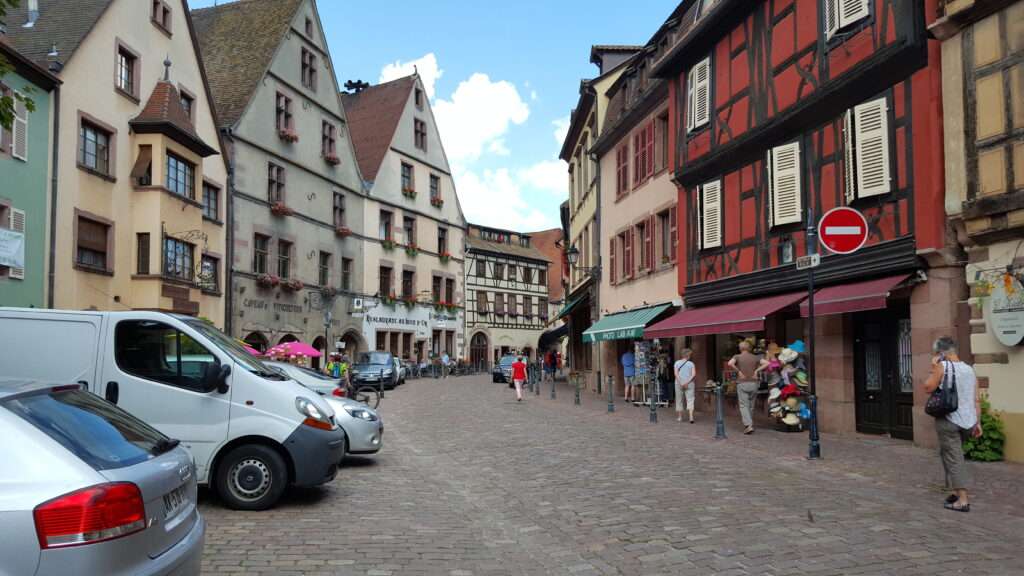
Deciding to rent a car in Europe
For most of my life, I never considered renting a car in Europe. Why would I? The convenience of hopping on a train, tram, or bus and landing right in the heart of any European city was unbeatable. I loved that about Europe—no need to navigate traffic or hunt for parking.
But about ten years ago, everything changed.
We were a group of seven, traveling on a tight budget. I scored cheap plane tickets to Paris, but our final destination was Switzerland. That’s when I made the decision: we’d rent a car. And that’s where this adventure begins.
Choosing Between a Manual or Automatic Rental Car in Europe
The best rental car deals in Europe almost always come with a manual transmission. Back then, I really needed a good deal.
My first car in the ‘90s had been a stick shift, and I figured it was like riding a bike. Once you know, you know… right? Even though I couldn’t remember the last time I’d actually driven a manual, I was confident enough—and motivated by the savings.
Everyone was hopeful it would come back to me quickly.
Picking Up the Car (and the First Surprise)
We landed in Paris, exhausted from the flight, and headed to the rental counter. I waived the insurance (thanks to my credit card’s excellent rental coverage), signed the paperwork, and was handed the keys to my very first European rental car.
We found it in the parking lot, loaded our bags, and I climbed into the driver’s seat—ready to go.
And that’s when the education really began.
Operating the Stick Shift (or Trying To)
We were ready to hit the open roads… or so I thought.
I put the van (yes, technically it was a van) into reverse—but it inched forward. Huh.
I tried again. It inched forward again. My sister got out to guide me so I wouldn’t hit the pole in front of the car. I gave it one more try. Still forward.
Not wanting to test my luck with Paris airport infrastructure, I marched back inside to ask for help—sheepishly.
The rental agent didn’t speak much English, but through a mix of hand gestures and very deliberate phrases, he explained I had to “press the lever, like a revolver” to change gears.
He came out and demonstrated. Sure enough, with the lever squeezed, it moved in reverse.
For the next two weeks, I lived in fear of shifting. Every time I tried to go into reverse or first gear, I wasn’t quite sure if we’d go forward or backward. I just remember announcing to the whole van, “Okay, I’m not sure which way we’re about to go… but here we go!”
Only months later did I realize the lever was a safety feature—intended only for shifting into reverse. But in my confusion (and due to the language barrier), I squeezed it every time I changed gears. Which, in hindsight, explains a lot.
Let’s just say: my ‘90s-era stick shift didn’t come with this level of suspense.
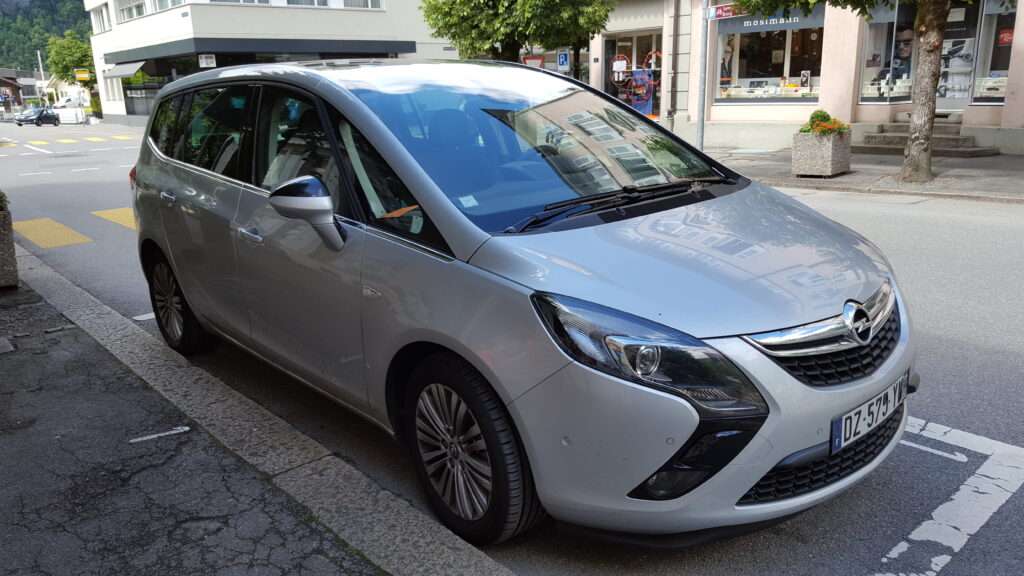
Photo above: My first rental car in Europe with the 5 + 2 seating. This little hatchback “van” accommodates 7 people and luggage.
How Small Are Cars and Roads in Europe? A Reality Check for American Travelers
The “Standard” European Minivan
My first rental car in Europe was classified as a van—because two seats popped up from the floor of the trunk to form a makeshift third row. But in American terms? This wasn’t a van. Maybe a station wagon on a good day. Still, we made it work.
Trunk Space? Barely.
Fitting our carry-on luggage into the sliver of trunk space left behind the third row became a game of Tetris. We wedged it all in just enough to close the hatch—and hoped nothing shifted mid-drive.
Roads, Cars, and Infrastructure: Everything’s Smaller
The cars (and “vans”) in Europe are compact for a reason: the roads are narrow, curvy, and tightly packed. Forget personal space. If it can move—bike, moped, bus, goat—it shares the street.
There were times I found myself driving on what I was sure was a bike path… until another car came the other direction. I’ve learned I need far less space than I once thought possible.
And it’s not just the roads—the concept of “space” in general is smaller in Europe. From elevators to grocery aisles to coffee cups, nothing is oversized. Nothing is wasted.
Pro Tip:
If you’re used to sprawling highways and roomy SUVs, be prepared to downsize expectations—from your vehicle to your driving habits. Book the smallest car that will realistically fit your group and luggage (I’ve never wished I had gone bigger). Smaller cars are easier to park and maneuver through tight alleys and village streets.
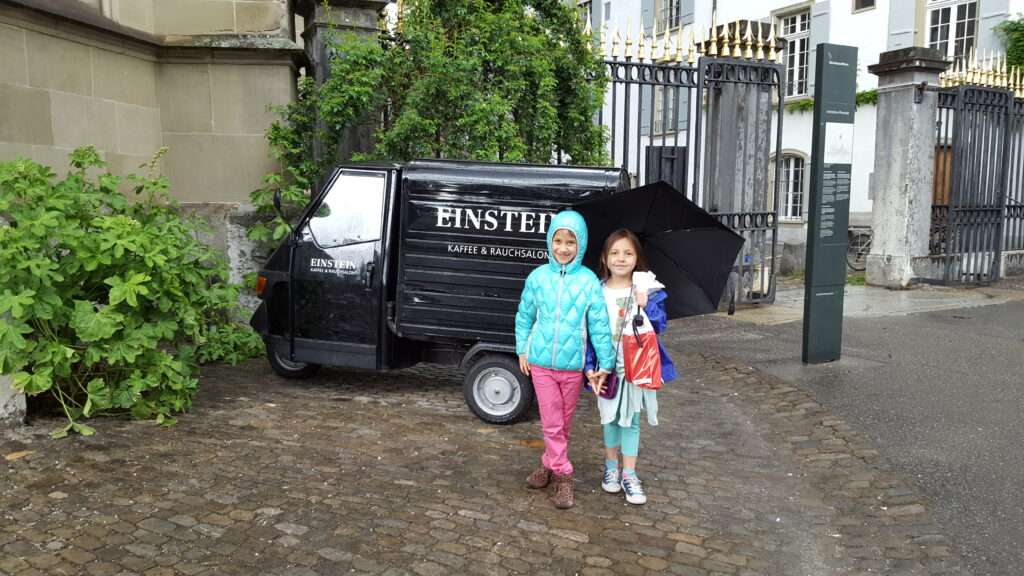
Photo above: This tiny truck in Bern, Switzerland is the perfect size for navigating European streets!
Surprise Speeding Tickets After a European Vacation
Surprise! You got a speeding ticket! (or some other ticket…)
That first trip went well enough that we did nearly the same thing the following year. I had figured out the stick shift situation and thought the worst was behind me.
But this time, as I was peacefully driving into the Alps one evening, a little radar box flashed in my face. It wasn’t clear what the speed limit was in that area—and I spent days ruminating over whether I’d been speeding, and what it might cost me.
A month or so later, my credit card was hit with a $35 administrative fee from the rental company. Shortly after, I received a fine from Switzerland for 40 CHF. Apparently, I’d been clocked going 1 kilometer over the speed limit.
That’s right: not even a mile over. But they found me—7,000 miles away—and made sure I paid. To their credit, the process was relatively painless: I paid it by phone with a credit card. But still—what a way to end a vacation.
Speed Cameras Are Everywhere
Remarkably, that’s the only speeding ticket in Europe I’ve received… that I know about.
There have been other times—especially in Italy—when I thought I got flashed. One time, I drove from northern Italy to Rome and noticed a sign in Italian that looked like it had something to do with speed. I stayed with the flow of traffic (a very fast flow of traffic) and hoped for the best.
Later I read that many Italian highways use plate-tracking systems—recording your entry and exit times and calculating your average speed. I was certain I’d racked up a fortune in fines. Months passed. Nothing came. But the anxiety? Oh, it stuck around.
The Waiting Game (aka The European Speed Trap Dread)
Here’s the thing: in Europe, speeding tickets can follow you home—sometimes weeks or even months later. You don’t always know if you’ve been caught until the fine appears on your credit card or in your mailbox.
And those speed traps? They often show up in places where the limit drops suddenly, then jumps back up—just long enough to trick a jet-lagged tourist who’s trying to read signs in a foreign language.
I now live in fear that one is slowly working its way to me. It hangs over me like a dark cloud every time I fly home.
At least in the U.S., I know when I’ve been caught, what it’ll cost, and sometimes—if I’m lucky—I’ll just get a warning.
Pro Tip:
Speed limits in Europe can change very suddenly—and many countries use automated cameras or average speed checks.
Even if you’re following traffic, you can still be fined.
→ Stick to posted limits, especially near tunnels, small towns, and interchanges.
→ Don’t assume “go with the flow” will protect you—it might only mean everyone gets a ticket.
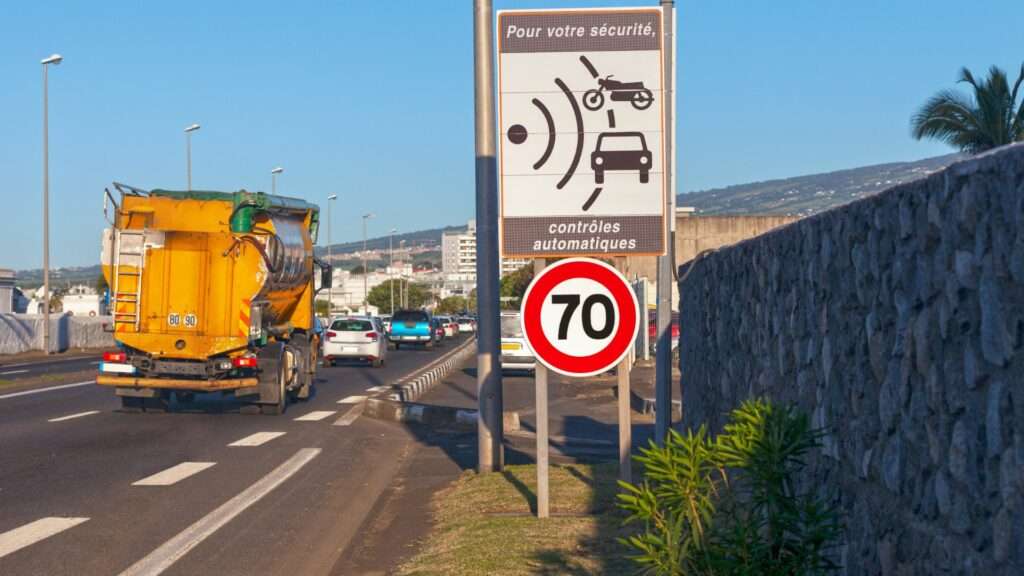
Photo above: The warning sign that there is a speed camera ahead in France. The round sign with the 70 is the typical European Speed Limit sign.
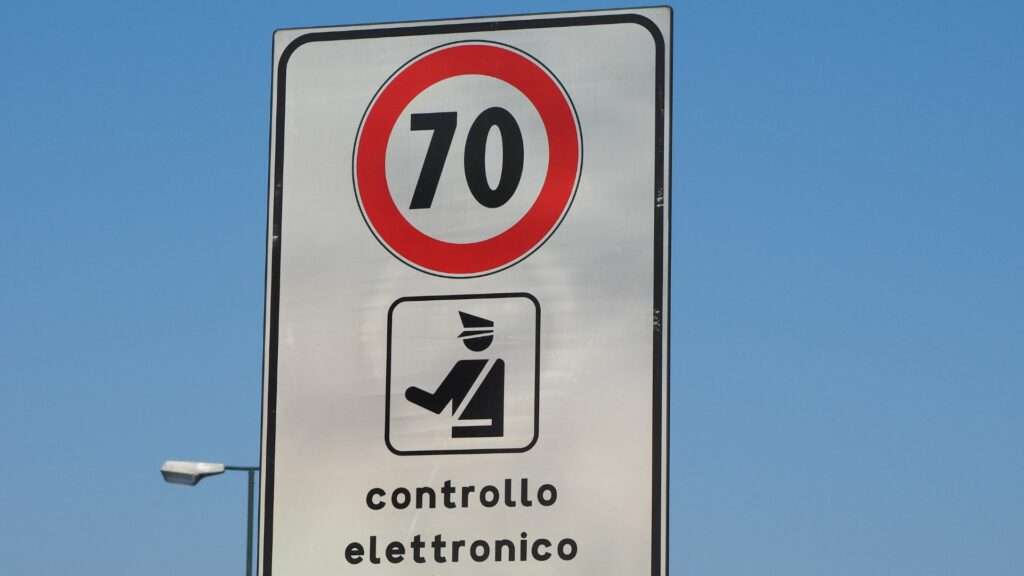
Photo above: An Italian sign warning they are monitoring the speed. If you are going over 70km, you might get a ticket.
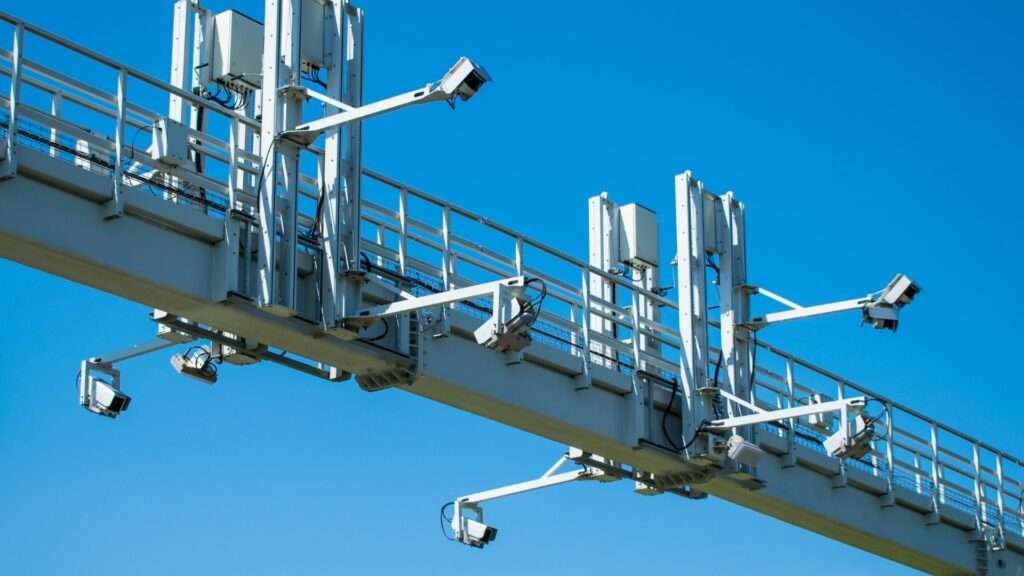
Photo above: Overhead speed cameras often found on major roads in Europe. Brake lights go on right before here.
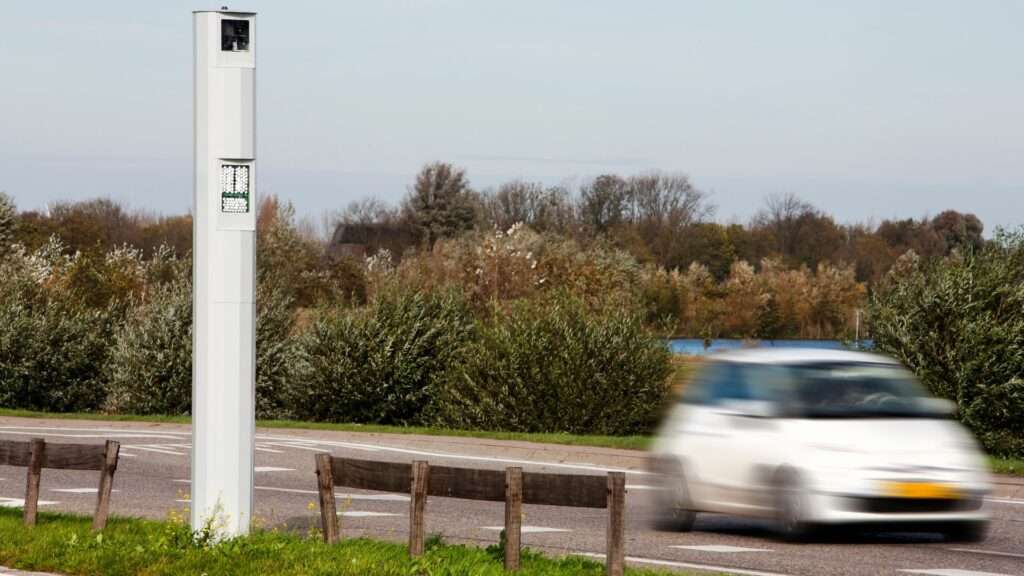
Photo above: A road-side speed camera, found all over the place in Europe.
Surprise! You Got Billed for Rental Car Damages – When Your Rental Car in Europe Was Already Damaged… But You Still Got Charged
The Mysterious Charges That Followed Me Home
It’s honestly a miracle that I haven’t scratched, dented, or totaled a car in Europe (yet). But that doesn’t mean I haven’t been charged for damages—damages I didn’t cause.
Two years ago, shortly after COVID restrictions eased, travel prices surged. That included rental cars in Europe. To score a reasonable deal on a manual transmission van, we picked one up in Versailles—outside of Paris.
They brought out a high-mileage vehicle with a large dent in the side. I was emailed a digital report documenting the damage and told not to worry about it.
Still, I babied that dented-up van for two weeks. I didn’t want to risk adding anything new.
The Return… and the Charges
We returned the car to Paris CDG Airport in a rush to catch our flight. I’d already filled the tank and handed the keys to the attendant.
He walked around the car, stopped at the dent, made some disapproving noises, and pointed it out to me.
I chuckled, rolled my eyes, and said, “It was already like that—check the report.”
Spoiler: he claimed there was no report.
My phone wouldn’t load the digital file, and he told me to email it once I got home. I refused to sign anything admitting to damage.
Before I even landed back in the U.S., Avis France charged me thousands of dollars. 😳
Since the damage wasn’t mine, I couldn’t file a claim with my credit card insurance.
The Great Avis France Customer Service Spiral
I spent weeks making international calls, sending emails, and tweeting into the void. They often didn’t answer the phone—and if they did, they hung up. When someone promised to “look into it,” they never followed up.
Eventually, I disputed the charge through my credit card company. I sent them the original report—complete with 39 documented damage points—and after a few months, they reversed the charges in my favor.
Avis France never followed up. No apology, no confirmation, no indication that anything had changed.
A More Cautious Approach
When I rented again last month—this time from Alamo France in Strasbourg—the car had visible damage, and again, they didn’t provide a paper report. They said it was all recorded electronically and told me to take my own photos, just in case.
I did. And thankfully, I had no issues returning the car to CDG this time.
But I’ll be honest—the fear of another “surprise” charge lingered through the whole trip.
Bonus Story: Greek Road Trip Edition
A few years ago, we rented a car in Greece for a road trip. The vehicle was already well-loved—with dings and scratches all over.
I started pointing out each issue as the agent marked them on the form. Eventually, he laughed, took his pen, and circled the entire car, saying:
“The whole car is damaged. Now you don’t need to worry anymore.”
Honestly? Iconic. And maybe the most honest approach I’ve seen yet.
Pro Tip:
Always take photos and videos of your rental car before you drive off—and when you return it. Even if the agency says everything is recorded electronically, protect yourself with your own timestamped proof.
If possible, get documentation in writing—especially when the car already has visible damage.
Rental Car Anxiety in Europe: Is Extra Insurance the Answer?
Sometimes I wonder if I should just say yes to that expensive insurance they offer at the rental car counter—just for peace of mind.
When booking through Expedia, I’m offered a discounted insurance option. But that coverage doesn’t seem much different (or better) than the free rental car insurance through my credit card.
Still… I wonder if the super-premium, wallet-draining option offered at the counter is actually different—if it really lets you walk away without a care, no matter what happens.
I’m just not convinced.
Even if I had full coverage that let me drop the car off in any condition, I don’t think I’d stop worrying about scraping walls or clipping mirrors. Every trip feels like starting from scratch—navigating tight roads and impossibly small parking spaces. That adjustment period is always a little stressful, no matter how many times I do it.
But when I return the car unscathed?
It’s oddly satisfying. Like I just cleared a level in a video game.
So maybe I do earn a little peace of mind—not from insurance, but from experience.
Pro Tip: If you’re risk-averse or just want less stress, full coverage at the counter might be worth the cost—but even then, don’t skip documenting the car at pickup. Paper trails matter. Even the rental counter coverage has lots of fine print.
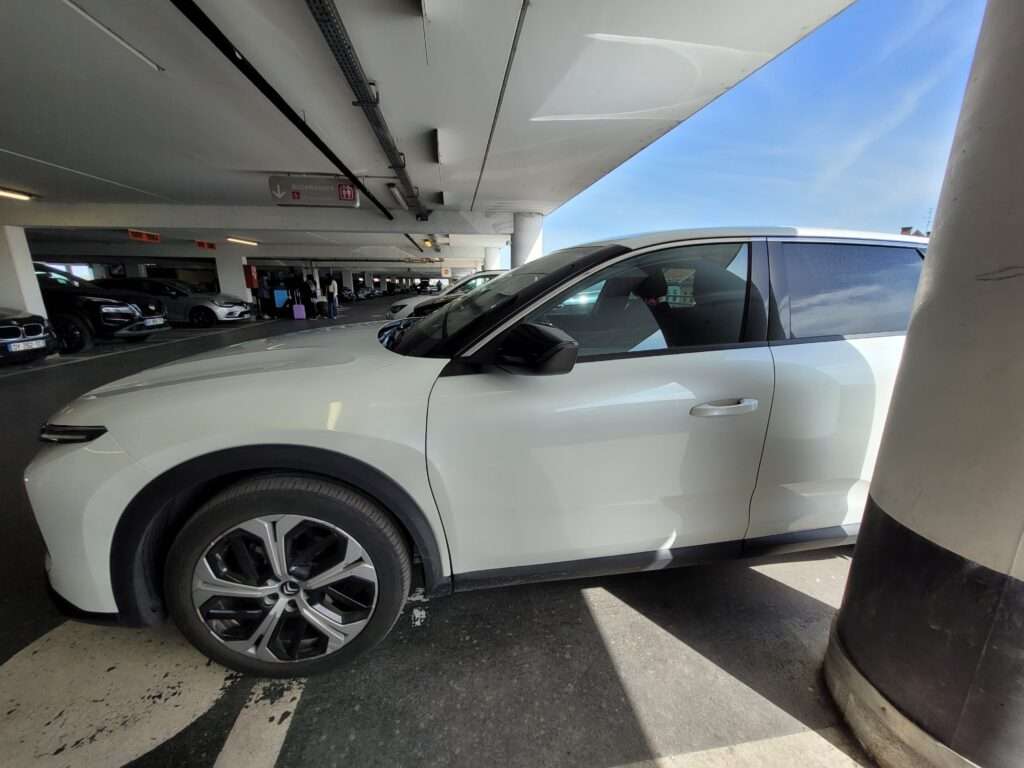
Photo above: A full-size car (not van) that we rented from Alamo in Strasbourg last month. It’s a lot easier to find a car for five people, than six or more.
Parking in Europe: The Hardest Part of Renting a Car Abroad
Everything Is Smaller—Especially the Parking Spaces
I’ve mentioned that everything in Europe is smaller. Nowhere is that more obvious than when it’s time to park.
Somehow I manage to slide rental cars through cobblestone alleys, hairpin turns, and impossibly tight streets. I survive merging with mopeds and weaving around ancient ruins. I manage… until I have to park.
That’s when my blood pressure spikes, my heart races, and the nervous sweat begins. Parking is, hands down, my #1 stressor when renting a car in Europe.
Parking Garages: Welcome to the Dungeon
The parking garage is my nemesis. Every time I see one, my heart jumps.
The entrance is narrow, dark, and steep. Once you’re in, there’s no backing out—literally. It’s a commitment.
There’s usually a colorful curb leading in, showcasing years of scratched paint. I inch down slowly, trailed by impatient locals. Will the car fit under that low ceiling? Is this rental van too tall?
Only once did I actually have to back out because the clearance was too low. But still—every time feels like it could be that time.
After grabbing a ticket and turning at a sharp, awkward angle (trying not to scrape anything), I enter a new level of stress: Will there be a spot I can fit into? No matter how many successful attempts I rack up, every parking garage feels like a potential disaster.
Why I Prefer Parking Lots (When I Can Find One)
Open-air parking lots are my safe space. I can see what I’m working with, line up properly, and breathe a little.
Unfortunately, they’re not always an option in city centers. Over the years, I’ve started Googling where to park large vehicles ahead of time—especially near landmarks—which has helped me avoid the worst garages.
That said, just last month I parked deep underground near the Louvre. By the time I emerged, I had declared (again), “I am never driving in Europe again!”
Also: 30 EUR for the privilege.
Street Parking Rules and Tricks
Street parking can be a great alternative—and sometimes even free!
In many cities, parking is free on:
Evenings
Weekends
Public holidays
But it’s not always simple.
Some zones are for residents only. Others require a parking clock—which most rental cars don’t come with. I usually snap a photo of the license plate, so I can pay using the number at a nearby meter (or app).
More recently, I’ve used QR codes on parking meters to pay and top off parking remotely—super helpful when dinner runs long.
But it’s not foolproof. In one city, the entire metro area had a three-hour daily limit, regardless of location. Even after moving the car and using a new meter, I hit the max and had no choice but… yep. Back to the garage.
“That’s What Bumpers Are For!”
A favorite memory: 20 years ago, I was couch surfing in Greece with my brother. Our host drove us around in a tiny car and—when it came time to park—wedged himself into the tightest spot I’ve ever seen.
He nudged the cars in front and behind, shrugged, and said:
“That’s what the bumper is for.”
That moment lives rent-free in my mind every single time I try to park on a European street.
Sara Joy’s Parking Pro Tips:
Research parking options near your destinations in advance (especially garages for large cars)
If it looks tight… it is.
Take a photo of your plate so you can easily pay at street meters
Download local parking apps when possible
Don’t assume parking garages will fit your vehicle—or your sanity
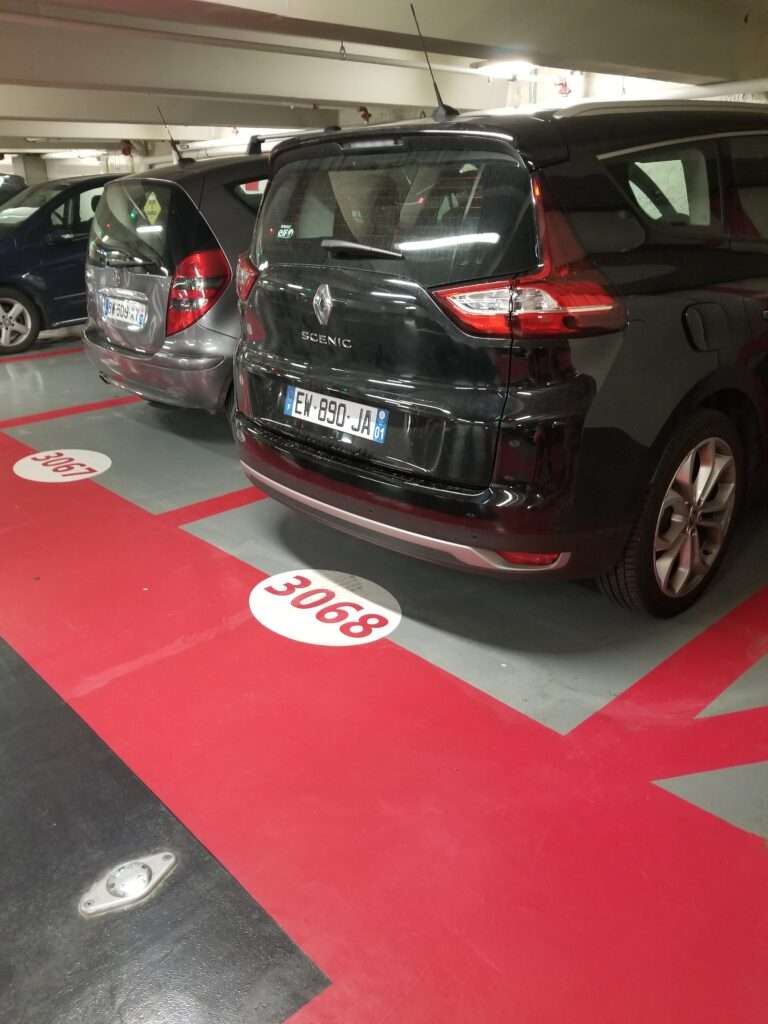
Photo above: The parking garage near Petite France in Strasbourg.
Do You Need an International Driver’s License to Rent a Car in Europe?
My Greece Wake-Up Call
Speaking of Greece, let’s talk about international driver’s permits (IDPs)—a topic I used to shrug off entirely.
Getting one isn’t easy for me. They’re only valid for one year, and the nearest AAA office that issues them is a two-hour drive (one way) from where I live. So unless I’m sure I need one, I usually skip it.
In most European countries, if your driver’s license is in English, you’re fine without the IDP.
But—there was one time I did need one.
The Night-Before-Departure Panic Search
The day before our 2019 trip to Greece—planned around a road trip through the Peloponnese peninsula—I got curious. A quick Google search turned up something alarming: Greece requires an International Driver’s Permit to rent a car.
I was skeptical. I’d rented cars all over Europe with no issues. But the more I searched, the more it seemed legit. I could be denied the rental altogether.
So I took off work and made a surprise day trip to AAA to get one.
At the Counter: The Moment of Truth
At the Athens airport rental desk, the employee asked (almost hesitantly) if I had an international permit. He had that I really hope this doesn’t get awkward look.
When I pulled it out proudly, he visibly relaxed. The process continued without a hitch.
It turns out—yes—Greece still requires an IDP to rent a car if your license isn’t issued in the EU. And they do check.
We later met a family on the tram who were stuck in Athens, unable to get their rental car because they didn’t have the permit.
Pro Tip:
Check IDP requirements before your trip—don’t assume!
Some countries technically require it, even if enforcement varies. It’s inexpensive and easy to get (if you’re near a AAA), and it could save your trip.
How I Saved Over $1,000 on a Rental Van in Europe
Agreeing to drive a manual transmission isn’t the only way I’ve saved money on rental cars in Europe. Nope—over the years, I’ve learned that the more inconveniences I’m willing to accept, the more money I can save.
And sometimes, those trade-offs actually turn into wins.
The Price of Convenience (and the Reward for Skipping It)
I mentioned earlier that I once got a significantly better deal picking up a rental car in Versailles, just outside of Paris, rather than renting directly at the airport.
But last summer? I had to get even more creative.
Enter: Saarbrücken, Germany
While planning a road trip from Paris to Würzburg (with a drive down the Romantic Road), I started searching van rental prices in every town along the way.
And that’s how I found Saarbrücken.
I had never heard of it before—but it offered a manual “minibus” for over $1,000 less than the cheapest van I could find near Paris. Yes, a thousand dollars!
The Unexpected Upside
It sounds inconvenient, but it actually worked out beautifully. We took a high-speed train from Paris to Saarbrücken, cutting down our travel time both ways. And the vehicle?
It was the biggest, most luxurious van we’ve ever rented. Everyone loved it. And the price was unbeatable.
Pro Tip:
When renting a car in Europe, expand your search radius beyond major cities and airports.
Check train-accessible towns along your route—especially if you’re looking for a specific type of vehicle like a van or minibus.
The savings can be well worth the effort.
How I Score the Best Rental Car Deals in Europe
These are my go-to strategies after years of trial, error, and a few near-misses.
Book Early, Book Smart
- I make multiple refundable bookings for different dates and pickup spots on Expedia.
- Locking in early prices means I always have affordable options.
- I cancel anything I don’t need once the trip is set.
Get Creative with Locations
- If airport prices are high, I check Google Maps for nearby cities with better rates.
- In a pinch, I look at towns along our route—often the best deals are just outside major hubs.
- I’ve taken high-speed trains to other cities just to grab a better rental!
Stick with Trusted Companies
- I stick with names I know: Avis, Budget, Sixt, Europcar, Alamo, Enterprise.
- Some lesser-known companies have terrible reviews—it's not worth the risk.
What I Look For
- Unlimited mileage (always my preference when possible).
- The smallest car that reasonably fits my group.
- Willing to drive a manual, but I’ll pay a little extra for an automatic if its a negligible difference.
Recheck & Swap When It Makes Sense
- Once dates are locked in, I compare Expedia, Costco, Booking.com for better prices.
- I’ll switch to a better rate—even a prepaid one—once I’m confident.
- Sometimes I have two reservations the morning of the trip and cancel one on the go!
Bonus Tip: Share Your Flight Info
- I always include my flight number with airport rentals.
- Most agencies will hold your car and rate, often up to 24 hours—in case my flight is delayed.
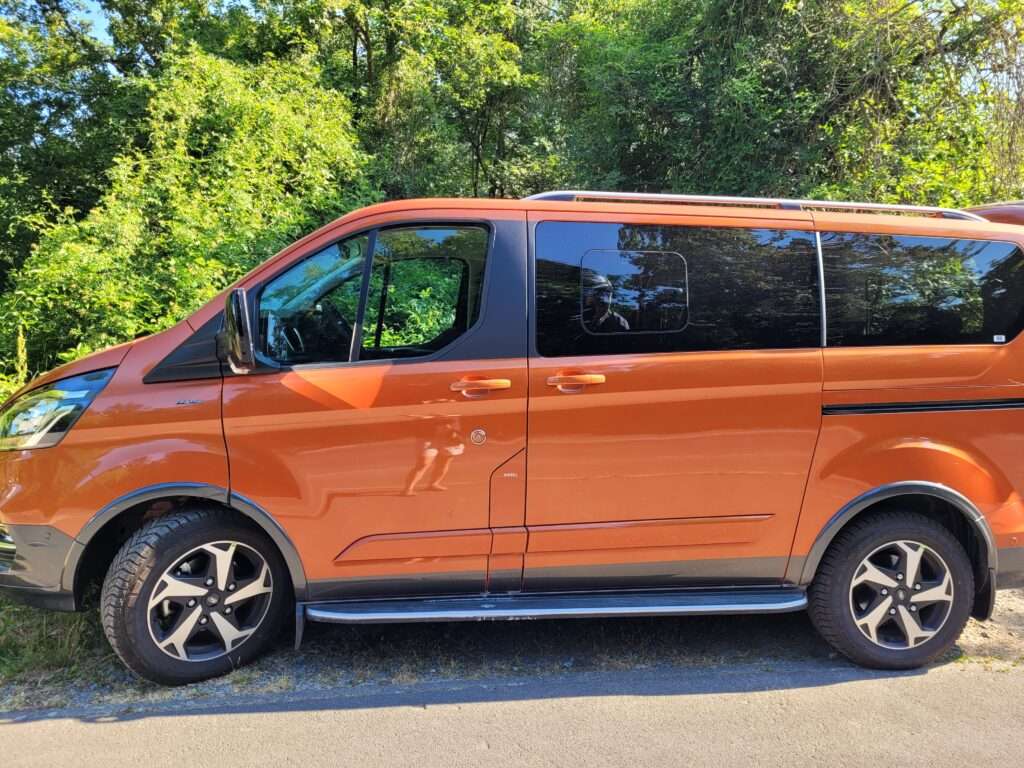
Photo above: The minibus we rented from Hertz in Saarbrucken Germany.
Rental Car Contracts in Europe: Cross-Border Rules, Tolls, and Mileage Limits
Taking the Car Across Borders
Last month, I was caught off guard when I learned there would be an extra fee to take my rental car out of France. That’s not usually the case—most European countries are included in the base fare. But this time, Switzerland wasn’t.
Rather than pay the added fee, I parked near the Swiss border and walked into the country. One of the rare times I’ve entered a new country on foot.
Limited vs. Unlimited Mileage
Another detail that can affect your road trip budget: mileage limits.
Most airport rentals include unlimited mileage, but off-airport rentals (which often cost less) sometimes have a daily kilometer cap.
When that happens, I use Google Maps to estimate how many miles our trip will cover. If I’ll go over, I calculate whether the per-kilometer overage fee will still make it cheaper than the more expensive unlimited option.
One year in Spain, we decided to park our van in Girona and take a train into Barcelona—not only to avoid driving in the city, but to save miles. It worked out perfectly. The train was fast, and we kept our trip just under the limit.
Toll Roads in Europe: Know Before You Go
Google Maps does a great job offering route options with or without toll roads. The toll roads are faster—but not cheap. Over a two-week trip, they can really add up.
I once drove through a tunnel between Italy and France that charged the highest toll I’ve ever paid. (Still not over it.)
One exception: Switzerland. You can drive on their highways all year with a 40 CHF vignette—a flat fee that you buy at the border. Compared to other toll systems, it’s a pretty good deal.
Paying at the Toll Booth
Most toll booths in Europe now accept contactless credit cards, which makes things easy.
But I’ve still hit booths that only take cash or have malfunctioning card readers—especially on rural routes. So I always carry a bit of cash and a backup credit card, just in case one gets declined or flagged for fraud while I’m holding up a line of cars.
Choosing the Right Lane
Every toll booth has signs over each lane showing what kind of payment it accepts—look for the card symbol.
Some tolls are flat fees, clearly posted. Others are distance-based. In those cases, you’ll take a paper ticket when you enter the highway (don’t lose it!) and pay based on the exit point.
Most tolls fall in the range of a few euros up to €20 or so.
To Exit or Not to Exit
In most countries, you’ll see signage warning of tolls ahead. If you don’t want to pay, you can often exit the highway beforehand.
In France, tolls are labeled as “Peage”. Sometimes, the booths get backed up—and the traffic jam afterward can be something else. I once exited a 20-lane toll plaza that bottlenecked into two lanes. It was chaos. But also kind of amazing? Let’s just say… aggressive driving is a survival skill in moments like that.
Rental Contract Quick Tips:
Always check if cross-border travel is included
Confirm whether your rental has unlimited or limited mileage
Research toll systems in the countries you’ll be driving through
Carry a small stash of euros + a backup credit card
Don’t assume you can take the scenic route toll-free—Google might reroute you mid-drive!
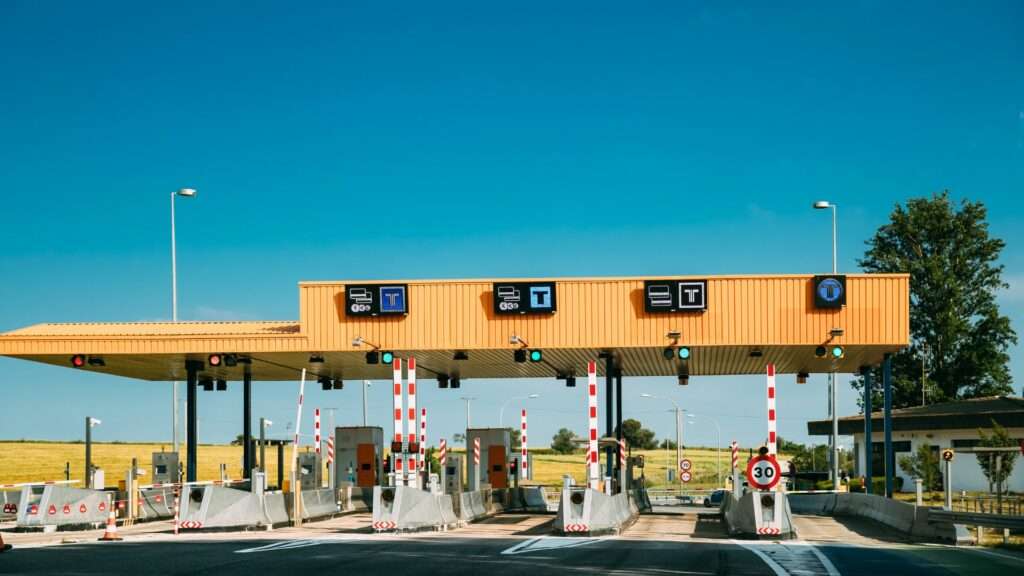
Photo above: Showing a French toll booth, and the lanes with various labels.
Yes, There Are A LOT of Roundabouts in Europe
Since I mentioned toll booths, I must also mention roundabouts—because in Europe, they’re everywhere.
Whenever I fly into Paris and glance out the window as we descend, I can spot roundabout after roundabout below. They’re like crop circles, but for traffic.
The Arc de Triomphe Roundabout: A Right of Passage
In Paris, I once drove into the roundabout at the Arc de Triomphe, which may be the most intense traffic circle I’ve ever encountered. I couldn’t tell how many lanes there were—maybe ten? Maybe more?
When I didn’t know which exit to take or how to merge across the mystery lanes, I just stayed in the loop. Literally. I kept circling until I was ready and able to make my escape.
My Roundabout Strategy (Or Lack Thereof)
Most roundabouts are more manageable—usually one to three lanes. I still haven’t quite cracked the code on multi-lane roundabouts, so I default to this strategy: stick to the outer lane, and exit when I can.
So far, this has worked.
No honking, no accidents. And as anyone who’s driven in Europe knows, Europeans are not shy about honking—so I take that as a good sign.
The Roundabout With a Statue of Liberty
In the Alsace region of France, there’s a roundabout with a 12-meter Statue of Liberty replica inside it. It was built to honor Bartholdi, the sculptor of the original statue, who was from that very area.
Let’s just say… sometimes I intentionally take a couple extra loops around a roundabout—strictly for sightseeing purposes.
From Paris to My Hometown
In recent years, my little hometown got a few roundabouts, and I suddenly felt like a seasoned pro—while everyone else was still trying to figure them out.
They really are efficient at moving traffic. Now that I’m used to them, I’ll take a roundabout over a stoplight any day.
Pro Tip:
If you’re nervous about European roundabouts, stick to the outer lane and go around as many times as you need to until you’re ready to exit.
Just remember: right of way is usually for those already in the circle—so yield before you enter!
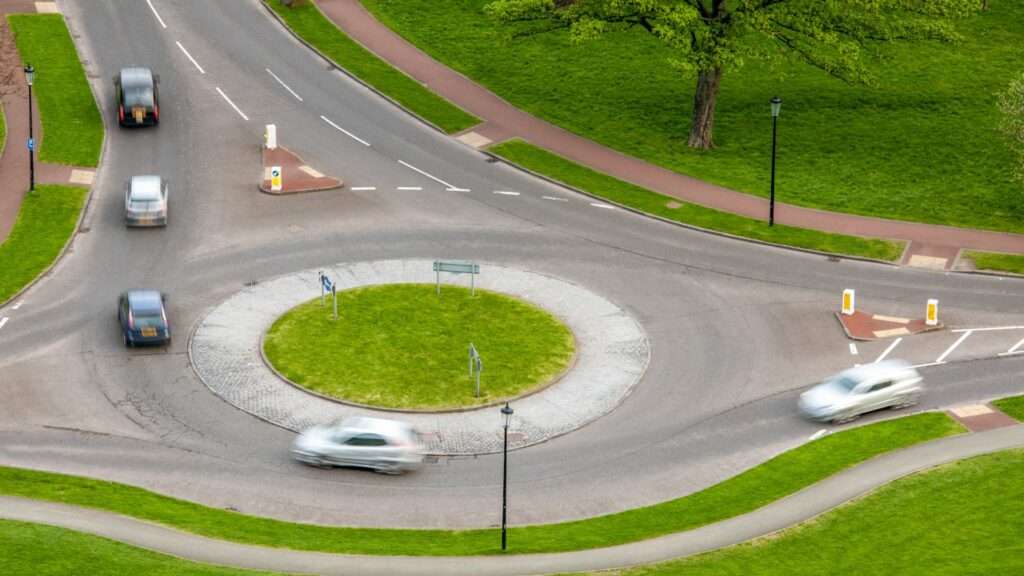
Photo above: A simple country-side roundabout with a single lane.

Photo above: The many laned roundabout at the Arc de Triomphe in Paris.
Getting Gas in Europe
Sooner or later, every road trip comes to that moment: the first gas stop.
Over the years, I’ve had a few rental cars that ran on diesel—something I didn’t expect the first time. Now, I always ask what kind of fuel the car takes before I leave the rental lot. Actually, it’s usually something the attendant makes quite clear.
You can also usually find a sticker inside the fuel door that says what type it is.
Wait, Gas Is How Much?!
Gas prices in Europe may look deceptively low—but it’s sold by the liter, not the gallon. Once you do the conversion, it’s usually more expensive than gas in the U.S.
That said, most European cars are far more fuel efficient, so the total cost of fuel often balances out over the course of a trip.
How to Fill Up in Europe
Gassing up is mostly similar to home:
Most stations have card readers at the pump
If not, you can usually go inside and pay
Many stations also have bathrooms, snacks, souvenirs, or even a small café
Before returning the rental car, I always plan to top off the tank. Airports usually have a gas station nearby, but when I’m unsure, I just set Google Maps to “gas station” or plug one into my GPS.
One helpful thing: many European pumps are automated, so even if the station itself isn’t open (hello, early morning flight), you can still fill up using a card.
Pro Tip:
Always confirm the fuel type—don’t assume it’s regular!
Keep in mind that stations might be unattended early or late, so a working credit card is essential
Look for stations near your return location before your final day
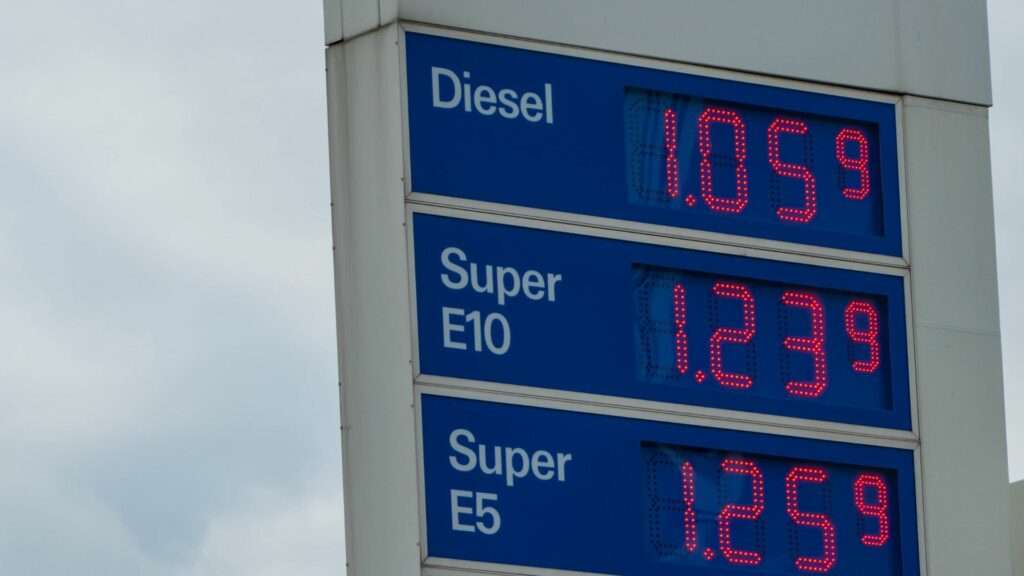
Crossing Borders in Europe (Oh Wait... We Already Did?)
I used to get a little nervous when crossing borders between countries in Europe—not because I thought I’d be turned away, but because I didn’t want to mess up the process.
Would I have my passport ready in time? Would I understand the agent’s question in another language? Would they somehow discover I had no business driving a stick shift?
But once you’re inside mainland Europe (Schengen Zone), borders are almost seamless.
Wait… Was That the Border?
Most of the time, you don’t even realize you’ve crossed into another country until you notice that:
The road signs are suddenly in a different language
The license plates have changed
The gas prices are listed in a different currency
There’s usually no checkpoint, no agent, and no need to stop.
Switzerland: The One That Still Feels Like a Border
Switzerland is a bit of an exception. It’s not part of the EU, and when you drive in from a neighboring country (like France or Italy), you’ll often find a real border crossing with a line of cars.
But don’t worry—it’s usually not about passport checks.
Most drivers are just there to buy a motorway vignette, which is Switzerland’s version of a highway toll pass. If you’re not driving on the motorways, or if you already have one, you can often just keep going through a separate lane.
And if you’re walking across the border? Odds are, there won’t be anyone there to stop you.
Pro Tip:
Inside the Schengen Zone, border crossings by car are usually invisible—but make sure to keep your passport accessible just in case. Additionally, I have been hearing about some countries starting to reimplement border checks inside the zone.
Switzerland does require a vignette for motorway use (40 CHF/year). You can buy one at the border or at most gas stations near the crossing. If you didn’t rent the car in Switzerland, it probably doesn’t have the sticker. But at least with the sticker, you don’t have to stop at toll booths all over the country.
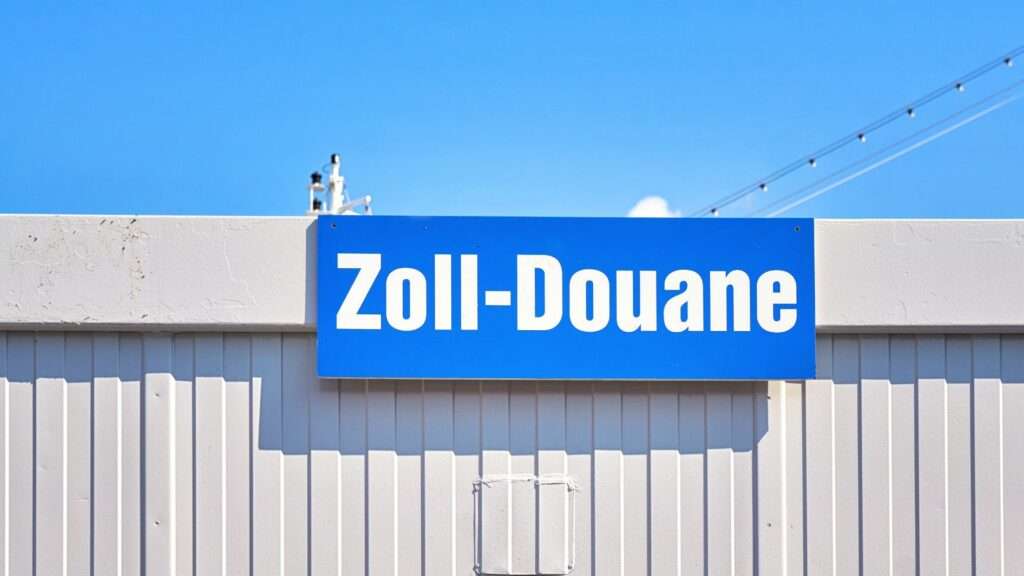
Ten years, and still going strong
I never imagined I’d still be renting cars in Europe ten years later.
There have definitely been moments—usually involving parking nightmares or the anxiety of possible speeding tickets—where I swore I’d never do it again. But somehow, I keep coming back to it.
Because the truth is, we’ve made some incredible road trips, visiting places you simply can’t get to without a car. And I wouldn’t want to have missed those experiences.
As my kids have grown (they’re full-sized adults now—how did that happen?), it’s become harder and more expensive to find a full-size van that fits everyone comfortably. So lately, we’ve started mixing things up—adding train or bus segments to our trips, or sometimes skipping the car altogether.
Last year in Athens, we didn’t rent a car at all—aside from getting back to the airport. We stayed in the city for the whole week, and my kids actually said they liked it better than driving around. Go figure.
This past Christmas, we did a loop through Southern Spain—Madrid, Seville, Granada, and Córdoba—using trains and buses the entire way. It was wonderfully low-stress. We didn’t have to think about parking when choosing where to stay, and we could book accommodations right in the heart of the old towns, walking everywhere or grabbing a tram or taxi if needed.
We’re slowly realizing that we don’t always need a rental car. And in some cases, it’s better without one.
That said, there are places where a car is still essential—the Loire Valley in France, the Romantic Road in Germany, the Peloponnese in Greece, the English countryside. In those areas, we felt more freedom and less stress, and the car became a tool that enhanced the trip, rather than a burden.
For me, the most stressful car rental experiences have been the ones where the car wasn’t really necessary—where it created more logistical challenges than it solved.
💬 Final Thought:
When a car gives us access to places we’d otherwise miss, it’s worth it. But when the destination itself is better explored on foot, train, or tram… we’re learning to let the car go.

Photo above: Senanque Abbey in southern France

Photo above: The Ochres of Luberon, Roussillon, in France.

Photo above: Corinth, Peloponnese peninsula in Greece.

Photo above: Road-trip in Bernese Oberland, Switzerland

Photo above: Road-trip through the Loire Valley in France

Photo above: Rocamadour, France!
Maybe we should just take the train
The first time our whole family traveled to Europe, I told Gary we didn’t need a rental car.
I had backpacked across Europe in my twenties with nothing but a Eurail pass. I’d lived in Europe multiple times without ever needing a car. It never crossed my mind that driving would be better.
I told Gary how convenient it is to take fast trains and pop up right in the middle of the action—no parking, no stress.
But he wasn’t convinced.
He told me he was only coming if we rented a car.
So we did.
Fast forward to a couple of weeks ago, as I was planning our summer trip to Spain. Gary looked over my shoulder and asked:
“Why can’t we just take the train?”
I blinked.
He pointed out how well it worked when we did our Southern Spain loop last Christmas—how we didn’t have to think about parking or navigating old city streets.
“The kids have space, there’s Wi-Fi, someone brings coffee and snacks, and it goes nearly as fast as the plane,” he said.
I just stared at him.
After all these years, he was the one insisting we take the train.
Honestly? The whole family seems happy about it.
When I told my oldest daughter (who decided to join us last minute) that our rental car reservation no longer worked for our group size, she said:
“Mom, rental cars just stress you out anyways.”
A few hours later, I mentioned it to my youngest.
“Mom, rental cars just stress you out anyways.”
They’re not wrong.
And guess what?
Now that I know I don’t have to deal with a rental car this time—I’m genuinely excited.
If you’ve read this far, you definitely understand why I’m shouting:
“Yay!”
💬 Final Thought:
I may have a love-hate relationship with rental cars, but one thing’s for sure: I’ve learned how to drive—and now I’m learning that I don’t always need to.






